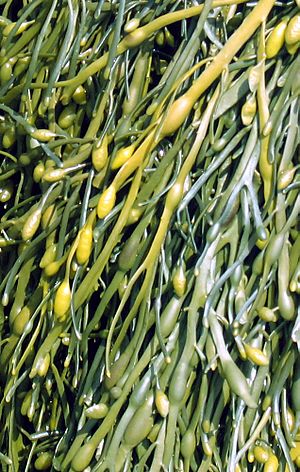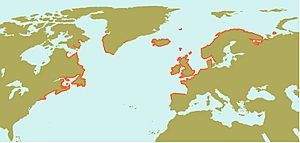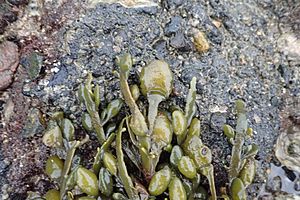Ascophyllum facts for kids
Quick facts for kids Ascophyllum |
|
|---|---|
 |
|
| Scientific classification | |
| Genus: |
Ascophyllum
|
| Species: |
nodosum
|
 |
|
| Distribution | |
Ascophyllum nodosum is a very common type of seaweed. It is a large, tough brown alga that loves cold water. You might know it by other names like rockweed or knotted wrack. This seaweed is the only species in its group, called Ascophyllum.
It grows only in the northern Atlantic Ocean. You can find it along the coasts of north-western Europe, from the White Sea all the way to Portugal. It also lives on the east coast of Greenland and the north-eastern coast of North America. Warmer waters stop it from growing further south.
Contents
What it Looks Like
Ascophyllum nodosum has long, strong, and leathery parts called fronds. These fronds can grow up to 2 meters (about 6.5 feet) long! They branch out in an uneven way.
Along the fronds, you'll see big, egg-shaped air bladders. These bladders are like little floats that help the seaweed stand up in the water. The seaweed attaches itself to rocks and boulders using a strong base called a holdfast. Its color is usually olive-green or olive-brown. The fronds are a bit flat but don't have a middle rib like some other seaweeds.
How it Reproduces
Each Ascophyllum nodosum plant is either male or female. They produce tiny cells called gametes in the spring. These gametes are made in special yellowish bumps called receptacles, which are on short branches of the plant.
Different Kinds
Sometimes, you can find slightly different versions of this seaweed. For example, a smaller type called Ascophyllum nodosum var. minor has been found in Northern Ireland.
There are also forms that float freely in the water. One example is A. n. mackaii. You can find this type in very calm places, like the ends of sea lochs in Scotland and Ireland.
Where it Lives and Grows
Ascophyllum nodosum mostly lives in sheltered spots on the shore. It likes the middle part of the beach, which is covered by water at high tide and exposed at low tide. Here, it often becomes the most common type of seaweed.
This seaweed can live in many coastal places. It ranges from calm estuaries (where rivers meet the sea) to coasts that are a bit more exposed to waves. It often takes over the area between the high and low tide marks. However, you won't usually find it on very exposed shores. If it is there, its fronds are often small and damaged.
This seaweed grows quite slowly, about 0.5% each day. A patch of it can weigh about 40 kilograms (88 pounds) per square meter. It can live for a long time, sometimes 10 to 15 years! It usually grows alongside other seaweeds like Fucus vesiculosus and Fucus serratus. How it grows also depends on how salty the water is, how strong the waves are, the temperature, and how much it dries out when the tide is low. It takes about five years for a plant to be able to reproduce.
A small red alga called Polysiphonia lanosa often grows on Ascophyllum. It forms thick clumps and its roots grow into the Ascophyllum plant. Some people thought it was a parasite, but it only uses Ascophyllum for support, not for food. So, it's actually an epiphyte, which means it grows on another plant but doesn't harm it.
Where it is Found

This seaweed has been found in many places in Europe. These include Ireland, the White Sea, the Faroe Islands, Norway, Britain, the Isle of Man, and the Netherlands. In North America, it's found in the Bay of Fundy, Nova Scotia, Baffin Island, Hudson Strait, Labrador, and Newfoundland. It was once found by accident near San Francisco, California, but it was removed quickly because it could have become an invasive species (a species that spreads and harms the local environment).
How We Use It
Ascophyllum nodosum is harvested for several uses. It's used to make alginates, which are substances used in many products, from food to medicines. It's also used to make fertilizer for plants and as a food ingredient for animals and even humans.
For a long time, people have used it as a natural fertilizer for many crops. This is because it has important plant nutrients like nitrogen, phosphorus, and potassium. It also contains smaller amounts of other helpful nutrients like calcium, magnesium, sulfur, manganese, copper, iron, and zinc. Plus, it has natural plant hormones and other good things like amino acids and proteins, which are all great for farming.
Countries like Ireland, Scotland, and Norway are big suppliers of alginate to the world.
Ascophyllum nodosum is also often used as packaging material. For example, it's used to pack live baitworms and lobsters when they are shipped from New England to other places. Sometimes, when Ascophyllum is used this way, other small sea creatures like crabs or snails can accidentally be introduced to new places. This happened in the San Francisco Bay area.
Monitoring the Environment
Because you can tell the age of different parts of A. nodosum, it has been used to check how much heavy metals are in seawater. It can collect a lot of zinc, for example, showing how much pollution is in the water.
See also
 In Spanish: Alga de roca para niños
In Spanish: Alga de roca para niños

